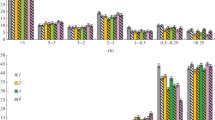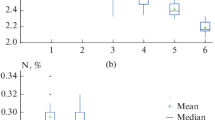Abstract
This article presents the results of research on the impact of no-till technology on the natural bulk density and macro- and microaggregate composition of the topsoil (0–20 cm) in different subtypes of chernozems before sowing and during the growing season. Haplic Chernozems (Loamic, Aric, Pachic) and Haplic Chernozems (Loamic, Aric) were studied. For all chernozems, improvement of physical properties was recorded when no-till was introduced in comparison with the control. Four and six years of crop growing without tillage did not cause any compaction of Haplic Chernozems (typical and ordinary subtypes). On the plots with direct sowing, the microaggregate composition of typical chernozems was characterized by a higher proportion of coarse fractions (>50 µm) in comparison with the control. Probably, this indicates the development of microaggregation similar to that under natural cenoses, which are characterized by a relatively high content of the fraction 50–250 µm, upon the transition to no-till. In all subtypes of chernozems under no-till, the water stability of aggregates increased. The share of agronomically valuable aggregates in typical chernozem also increased, which may be associated with an increase in the input of water-soluble organic matter into the soil during no-till, because this technology excludes translocation of plant residues into the soil. In southern chernozems, this effect was manifested only for fractions >7 mm, while water stability of finer aggregates was mainly due to the calcium content regardless of the type of tillage.


Similar content being viewed by others
REFERENCES
H. P. Allen, Direct Drilling and Reduced Cultivations (Farming Press, Ipswich, 1981; Agropromizdat, Moscow, 1985).
Yu. I. Baeva, I. N. Kurganova, V. O. Lopes de Gerenyu, L. A. Ovsepyan, V. M. Telesnina, and Yu. D. Tsvetkova, “Change of aggregate composition of various type soils during fallow succession,” Byull. Pochv. Inst. im. V.V. Dokuchaeva 88, 47–74 (2017). https://doi.org/10.19047/0136-1694-2017-88-47-74
V. A. Ban’kin, “Other farming system is required,” Zemledelie, No. 1, 45–48 (2019).
A. I. Baraev, Soil-Protective Arable Farming (Kolos, Moscow, 1975) [in Russian].
V. P. Belobrov, K. N. Abrosimov, E. B. Skvortsova, A. Ya. Aidiev, S. A. Yudin, and A. Yu. Kulenkamp, “Microstructure and porous space of chernozems,” in Proc. Sci. Conf. “Current Problems of Soil Science, Ecology, and Arable Farming” (Kursk, 2016), pp. 37–41.
V. P. Belobrov, A. Ya. Aidiev, S. A. Yudin, A. Ya. Voronin, Z. S. Artem’eva, and A. Yu. Kulenkamp, “Database on minimization of tillage of ordinary chernozem during prolonged field experiment,” in Proc. Sci. Conf. “Current Problems of Soil Science, Ecology, and Arable Farming” (Kursk, 2014), pp. 22–27.
V. R. Williams, Arable Farming with Basics of Soil Science (Sel’khozgiz, Moscow, 1951), Vol. 4.
N. G. Vlasenko, N. A. Korotkikh, and I. G. Bokina, Phytosanitary Situation in Crops in the No-Till System (Siberian Research Institute of Soil Management and Chemicalization of Agriculture, Novosibirsk, 2013) [in Russian].
V. M. Garmashov, Yu. I. Cheverdin, V. P. Belobrov, A. M. Grebennikov, V. A. Isaev, and V. A. Bespalov, “The influence of tillage on the agrophysical properties of migrational-mycellar chernozem,” Vestn. Ross. S-kh. Nauki, No. 3, 26–29 (2017).
P. L. Goncharov, The Scientific Basis of Grassing in Siberia (Agropromizdat, Moscow, 1986) [in Russian].
V. V. Dokuchaev, Russian Chernozem (St. Petersburg, 1883) [in Russian].
V. K. Dridiger, The Sweet Clover (Melilotus) (Agrus, Stavropol, 2014) [in Russian].
V. K. Dridiger, Practical Manual on No-Till Technologies of Crop Growing in the Dry Zone of Stavropol Region (Stavropol Agricultural Research Institute, Stavropol, 2016) [in Russian].
V. K. Dridiger, V. V. Kulintsev, R. S. Stukalov, and R. G. Gadzhiumarov, “Dynamics of agrophysical properties of soils during no-till cultivation of field crops,” Izv. Orenb. Gos. Agrar. Univ., No. 5 (73), 35–38 (2018).
V. K. Dridiger, A. V. Nevecherya, G. Taran, and N. V. Shapovalova, “Ipatovsk experience in no-till cultivation of field crops,” Agrosnabforum, No. 3, 35–40 (2017).
I. V. Zamotaev, V. P. Belobrov, A. N. Kurbatova, and D. V. Belobrova, “Anthropogenic and post-anthropogenic transformation of soils in L’gov region of Kursk oblast,” Byull. Pochv. Inst. im. V.V. Dokuchaeva, No. 85, 97–114 (2016).
N. A. Zelenskii, A. P. Aveenko, E. P. Lugantsev, and G. V. Mokrikov, Binary Seeding of Winter Wheat on Eroded Chernozems of Rostov Oblast (Don State Agrarian University, Persianovskii, 2010) [in Russian].
A. L. Ivanov, V. I. Kiryushin, E. N. Molchanov, I. Yu. Savin, and V. S. Stolbovoi, Analysis of Land Reform and Agroindustrial Complex over the Past Quarter of Century. Soil-Ecological, Technological, Institutional, and Infrastructure Aspects of Modernization. Land Service Report (Dokuchaev Soil Science Inst., Moscow, 2016) [in Russian].
A. L. Ivanov, I. Yu. Savin, and V. S. Stolbovoi, “Quality of agricultural soils in Russia,” Ross. S-kh. Nauka, No. 6, 41–45 (2013).
V. I. Kiryushin and S. V. Kiryushin, Agricultural Technologies: Manual (Lan’, St. Petersburg, 2015) [in Russian].
Classification and Diagnostics of Soils of the USSR (Kolos, Moscow, 1977) [in Russian].
N. N. Klyuev, “Ecology of agriculture in Russia,” Priroda (Moscow), No. 6, 26–32 (2017).
B. M. Kogut, Z. S. Artemyeva, N. P. Kirillova, M. A. Yashin, and E. I. Soshnikova, “Organic matter of the air-dry and water-stable macroaggregates (2–1 mm) of haplic chernozem in contrasting variants of land use,” Eurasian Soil Sci. 52, 141–149 (2019).
V. V. Medvedev, “Formation of macroagregates in chernozems,” Pochvovedenie, No. 11, 24–30 (1994).
World Reference Base for Soil Resources 2014, International Soil Classification System for Naming Soils and Creating Legends for Soil Maps (Food and Agriculture Organization of the United Nations, Rome, 2014; Moscow State Univ., Moscow, 2017).
O. I. Filippova, V. A. Kholodov, N. A. Safronova, A. V. Yudina, and N. A. Kulikova, “Distributions in humus horizons of the zonal sequence of soils in European Russia,” Eurasian Soil Sci. 52, 300–312 (2019).
A. S. Frid, I. V. Kuznetsova, I. E. Koroleva, A. G. Bondarev, B. M. Kogut, V. F. Utkaeva, and N. A. Azovtseva, Zonal and Provincial Standards of Changes in Agrochemical, Physicochemical, and Physical Indicators of Major Arable Soils of the European Part of Russia under Anthropogenic Impact (Dokuchaev Soil Science Institute, Moscow, 2010) [in Russian].
D. V. Khan, Organo-Mineral Compounds and Structure of Soils (Nauka, Moscow, 1969) [in Russian].
V. A. Kholodov, N. V. Yaroslavtseva, Y. R. Farkhodov, V. P. Belobrov, S. A. Yudin, A. Ya. Aydiev, V. I. Lazarev, and A. S. Frid, “Changes in the ratio of aggregate fractions in humus horizons of chernozems in response to the type of their use,” Eurasian Soil Sci. 52, 162–170 (2019).
V. A. Kholodov, N. V. Yaroslavtseva, V. I. Lazarev, and A. S. Frid, “Interpretation of data on the aggregate composition of typical chernozems under different land use by cluster and principal component analyses,” Eurasian Soil Sci. 49, 1026–1032 (2016).
G. N. Cherkasov, I. G. Pykhtin, and A. V. Gostev, Agrotechnological Policy of Implementation of No-Till and Surface Tillage of Soil for Grain Crops to Modernize Arable Farming (All-Russia Research Institute of Agriculture and Soil Erosion Control, Kursk, 2012) [in Russian].
E. V. Shein, Soil Physics (Moscow State Univ., Moscow, 2005) [in Russian].
A. V. Yudin and E. Yu. Milanovskii, “The microaggregate analysis of soils by the method of laser diffraction: the specificities of sample preparation and result interpretation,” Byull. Pochv. Inst. im. V.V. Dokuchaeva, No. 89, 3–20 (2017).
V. K. Dridiger, E. I. Godunova, F. V. Eroshenko, R. S. Stukalov, and R. G. Gadzhiumarov, “Effect of no-till technology on erosion resistance, the population of earthworms and humus content in soil,” Res. J. Pharm., Biol. Chem. Sci. 9 (2), 766–770 (2012).
F. Garcia-Oliva, M. Oliva, and B. Sveshtarova, “Effect of soil macroaggregates crushing on C mineralization in a tropical deciduous forest ecosystem,” Plant Soil 259 (1–2), 297–305 (2004).
IUSS Working Group WRB, World Reference Base for Soil Resources 2014, International Soil Classification System for Naming Soils and Creating Legends for Soil Maps, World Soil Resources Reports No. 106 (Food and Agriculture Organization of the United Nations, Rome, 2014).
D. R. Montgomery, “Soil erosion and agricultural sustainability,” Proc. Natl. Acad. Sci. U.S.A. 104 (33), 13268–13272 (2007).
J. Six, H. Bossuyt, S. Degryze, and K. Denef, “A history of research on the link between (micro)aggregates, soil biota, and soil organic matter dynamics,” Soil Tillage Res. 79, 7–31 (2004).
J. Six, E. T. Elliott, K. Paustian, and J. W. Doran, “Aggregation and soil organic matter accumulation in cultivated and native grassland soils,” Soil Sci. Soc. Am. J. 62, 1367–1377 (1998).
J. Six, E. G. Gregorich, and I. Kögel-Knabner, “Commentary on the impact of the impact of Tisdall & Oades,” J. Soil Sci. 33, 141–163 (1982).
J. M. Tisdall and J. M. Oades, “Organic matter and water-stable aggregates in soils,” J. Soil Sci. 63, 1–21 (2012).
Funding
This work was supported by the Russian Science Foundation, project no. 19-16-00053 (analysis of the structural state and microaggregate-size and particle-size distribution analyses) and by the Russian Foundation for Basic Research, project no. 19-016-00078 (soil sampling); the equipment of the Collective Use Center “Functions and Properties of Soils and Soil Cover” of the V.V. Dokuchaev Soil Science Institute was used.
Author information
Authors and Affiliations
Corresponding author
Ethics declarations
The authors declare that they have no conflict of interest.
Additional information
Translated by D. Konyushkov
Rights and permissions
About this article
Cite this article
Belobrov, V.P., Yudin, S.S., Yaroslavtseva, N.V. et al. Changes in Physical Properties of Chernozems under the Impact of No-Till Technology. Eurasian Soil Sc. 53, 968–977 (2020). https://doi.org/10.1134/S1064229320070029
Received:
Revised:
Accepted:
Published:
Issue Date:
DOI: https://doi.org/10.1134/S1064229320070029




